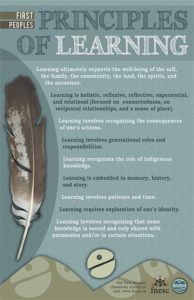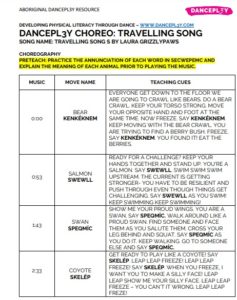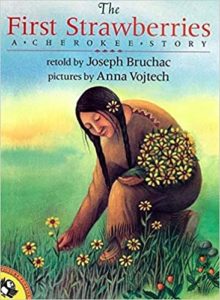Educators respect and value the history of First Nations, Inuit and Metis in Canada and the impact of the past on present and the future. Educators contribute towards truth, reconciliation and healing. Educators foster a deeper understanding of ways of knowing and being, histories, and cultures of First Nations, Inuit and Metis.
How I met standard 9 in my 490 practicum:
 When my Practice Evaluator came to visit my classroom, she complimented me on my ability to naturally embed the First Peoples Principals of Learning into my lesson plans. She told me I was able to embed it smoothly, without it seeming forced. This is something I took pride in with all of my lesson plans. Every lesson plans shows a Principal of Learning, and then a paragraph explaining how it would be implemented into that lesson. Inclusion and respect has always been at the fore front of my teaching journey. I was inspired by this practicum to find more ways of incorporating standard 9 into my future practice.
When my Practice Evaluator came to visit my classroom, she complimented me on my ability to naturally embed the First Peoples Principals of Learning into my lesson plans. She told me I was able to embed it smoothly, without it seeming forced. This is something I took pride in with all of my lesson plans. Every lesson plans shows a Principal of Learning, and then a paragraph explaining how it would be implemented into that lesson. Inclusion and respect has always been at the fore front of my teaching journey. I was inspired by this practicum to find more ways of incorporating standard 9 into my future practice.
First Nations Physical Education Lesson:
I found a great resource for First Nations lessons from a British Columbian website. I sought out and asked the school’s Physical Education teacher if I could teach a Physical Education lesson during my time at Hart Highlands Elementary. I developed and taught a First Nations themed Physical Education lesson, utilizing this accredited resource:
https://learn.pl3yinc.com/courses/aboriginal-dancepl3y-resource

On this resource’s website it describe the resource as “Dances and lesson ideas, designed to develop physical literacy as students discover music and movements from Aboriginal communities across Canada.” The creator of this resource says, “When I choreographed the songs for the Aboriginal DANCEPL3Y resource, it was a collaborative effort with local Elders, community members and students. We worked together to find the appropriate movements that are culturally appropriate and relevant. This technique required us to hear many of the Aboriginal stories and learn about the different perspectives when creating these movements. Our choreography process is an immersion of a cultural experience.” – Roxane
(Both quotes were taken directly from: https://learn.pl3yinc.com/courses/aboriginal-dancepl3y-resource)
With this lesson, I helped students develop a sense of themselves and local First Nations teachings through the Travelling song. The travelling song is a game from the SECWEPEMC Peoples. It was shared with permission using the DANC3PL3Y resource. It brings teachings from First Nations from British Columbia and shares it with all educators. This lesson was a fun way for students to hear traditional the SECWEPEMC spoken language and learn words through an interactive activity. First nations culture and symbolism was embedded to support all learners.
Through the development of this lesson, I focused on “Learning involves recognizing that some knowledge is sacred and only shared with permission and/or in certain situations.” I did this by ensuring that First Peoples knowledge could be shared before using it. I double checked the source of material (ensuring that the learning was not written down by a non-Indigenous person and published without permission). I ensured that this lesson used an accredited source to authentically bring First Peoples learning and symbolism into the Physical Education.
This lesson helped students develop a personal awareness and a respect for their bodies. Students participation allowed them to connect their physical movements to new learnings of local First Nations culture. An awareness for other cultures and a respect for First Nations language was also embedded into the lesson.
Aboriginal Ed Department Collaboration:
My school was lucky enough to have an Aboriginal Education Department headed by Mrs. D. Himmelspach. Her office was directly next to my classroom, which allowed me to collaborate and discuss ideas. In my third week, I planned and scheduled for a puppet show for my class. This puppet show focused on the 7 teachings, with a focus on Humility. The puppet show was very entertaining and involved wolf puppets teaching about how to be humble. Being able to use a resource like this was fantastic for my students!
FPPL In My Daily Classroom:
1). During my Arts Education lesson on November 30th, I moved the desks into a circle to better represent my intention of the students being equal. Students were each given a piece of paper and asked to draw something. When they were finished, I had every student pass their paper to the person on their right. Then they had to contribute to the art in front of them. We did this “rotation” until everyone in the class had contributed/added to everyone’s art. When the students go their original art back, they were able to see how all of us worked together to connect us!
2). Daily, I would have students sit in a circle on the carpet for my lessons. This would help resemble the classroom community as a circle were all students were equal. I would sit in the circle with them. f the lesson involved sharing something, I would introduce the talking stick and have the students pass the talking stick around. This was a very natural way for these teachings to be a natural part of my daily classroom.
3). I looked for ways to include First Nations perspectives into all lessons. For example, In my Health unit plan on healthy eating, I used a great kit from the DLC kit. The kit contained a lot of First Nations books, which I would read to my class during snack time. My particular favourite was “The First Strawberries” which I have already ordered on Amazon for my first classroom:

How I met standard 9 in my 491 practicum:
In 491, I found ways to make the learning more authentic and holistic. A student in the classroom had a grandmother who was a local elder, and we coordinated for the grandmother to come into the classroom and teach us all weaving. It was such a great experience to learn and have my student see her own culture embedded in the classroom! I also embedded the First Peoples Principals of Learning into all of my lessons, and made a strong effort to use storytelling and oral teachings in my lessons.
I continued to use the resources available to me as a District 57 employee. I took a fantastic DLC kit about indigenous astronomy out, to be used in my science unit. The kit included over 40 books about Indigenous knowledge relating to space. Since I was teaching a unit on the moon, this kit was perfect! I started each lesson by reading a book or legend from the kit, to add context and perspective over what we were learning. It also came with posters of the moon phases, which I hung on the whiteboard. I also coordinated with Aboriginal Education Department head (Ms. Dory) to schedule three presentations in my class about Truth, Courage, and Lying.
I also utilized the FirstVoice.com resource to teach a fantastic lesson on the Dakelh language:
Land as Our Teacher: Changing Engagement for Indigenous Learners (Middle Year Gr. 4-9) Storytelling, Land and Identity